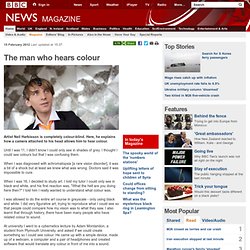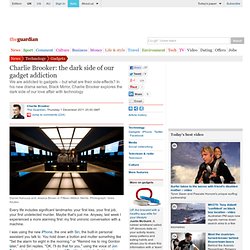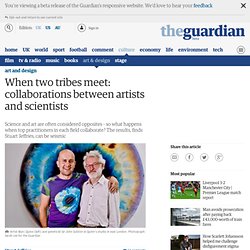

Adam Montandon's official Site. The man who hears colour. 15 February 2012Last updated at 15:37 Artist Neil Harbisson is completely colour-blind.

Here, he explains how a camera attached to his head allows him to hear colour. Until I was 11, I didn't know I could only see in shades of grey. I thought I could see colours but that I was confusing them. When I was diagnosed with achromatopsia [a rare vision disorder], it was a bit of a shock but at least we knew what was wrong. When I was 16, I decided to study art. I was allowed to do the entire art course in greyscale - only using black and white. At university I went to a cybernetics lecture by Adam Montandon, a student from Plymouth University, and asked if we could create something so I could see colour. If we were all to hear the frequency of red, for example, we would hear a note that is in between F and F sharp.
I started using it 24 hours a day, carrying it around in a backpack and feeling that the cybernetic device, the eyeborg, and my organism were completely connected. Shades of grey. Charlie Brooker: the dark side of our gadget addiction. Every life includes significant landmarks: your first kiss, your first job, your first undetected murder.

Maybe that's just me. Anyway, last week I experienced a more alarming first: my first unironic conversation with a machine. I was using the new iPhone, the one with Siri, the built-in personal assistant you talk to. You hold down a button and mutter something like "Set the alarm for eight in the morning," or "Remind me to ring Gordon later," and Siri replies, "OK, I'll do that for you," using the voice of Jon Briggs, better known as the voice of The Weakest Link.
And he sets everything up, just the way you wanted. Siri is a creep – a servile arselick with zero self-respect – but he works annoyingly well. When two tribes meet: collaborations between artists and scientists. Yes, Leonardo da Vinci was both artist and inventor.

True, Brian Cox was in that band before he gave it all up for the Large Hadron Collider. But in general, art and science seem to eye each other uncomprehendingly. Medical research charity the Wellcome Trust has long tried to make artists and scientists work fruitfully together by funding collaborations. Can the divide ever be breached? I talked to four scientists and four artists who have worked together to find out. The artist and the geneticist Just before 9/11, Marc Quinn did a portrait of Sir John Sulston, one of the genetic scientists who decoded the human genome. It was a radical departure for portraiture. "Well, yes," says Sulston, "but DNA gives the instructions for making a baby, not an adult.
A decade after their collaboration, Quinn and Sulston are meeting in the artist's east London studio. "Science simply means finding out about stuff, but in that process science is the greatest driver of culture," says Sulston.